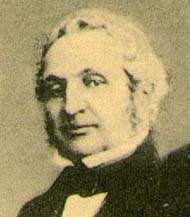

|
Bordeaux : Sites of Justice II
The Law Courts of Bordeaux (1846)

The Law-courts of Bordeaux inaugurated in 1846.
No longer would Bordeaux have a Palace of Justice after the destruction of the old Ombriere during the Revolution. An imperial decree of 1808 made in light of the deplorable state of the grounds of the Royal Court and especially of its prisons, had recommended the plan for a new Palace of Justice, but no one took it upon themselves to see it through. A new building could be hoped for only in 1831. Even then it was only a matter of building a room for criminal justice and a prison on the site of Fort Ha. The Royal Court and the Court of First Instance remained within the buildings of the former Guienne College.
|
This project was put into the hands of the architect of the municipality, Joseph Adolphe Thiac, (born in Bordeaux in 1800 and died in Bouscat in 1865). In doing so, he consulted the Judges of the Royal Courts , and submit his final plan in 1832 to the Council of civil buildings. It did not involve a Palace of Justice, but a modest sized building, of a square plan: a room for the Assize Court lost in the middle of a network of rooms and courts around an oblong waiting room ("Salle des Pas-perdus"). |

|
The Castle of Hâ circa 1640

|
Once the plans were approved, le demolition of Fort Ha commenced, November 10, 1835. Only the two towers of old chateau were kept and remain to this day : the so called Tower of the English and the Tower of the Minimes. A year later, the cut stones were piled up on the courtyard of the Republic that was called the Place of Armes and the workers began to dig the foundations. But the work was stopped suddenly. Apparently the architect and the commissioner had good reasons. Of course, they explained the interruption by the fact that the entrepreneurs attempted to raise the agreed price offering any excuse. True or false? In fact, a new project had already taken form. The decree of 1808 was to assemble all of the judicial organs in one single building. |
On the 10th of November, 1836 the Minister of the Interior authorised the mayor to oppose resuming work on the site. The General Counsellor took the opportunity to breach the contract. The litigation of the resilient carried on until 1838.
It was a "Palace -Temple" of Justice, whose facade would be raised the entire length of the courtyard. The colonnade copied the Parthenon, the Doric order without bases and the number of pillars (12) along the sides of the Temple of Aphea on the Isle of AEgina. The Assize Court was to be in the centre and the hearing rooms of the Royal Court and the Civil Court were divided along the right and the left of a large rectangular waiting room, where as the prisons of Ha, which were said to be conceived of based on the Pennsylvanian penitentiary model, were situate at the back of the building. And thus, the Palace of Justice of Bordeaux, as it is today, is also somewhat the fruit of involuntary labour of the delays of justice in the XIX century.
On the 9th of August, 1838, the new project accompanied by an estimate was finally adopted by the Ministry. The work began in 1839. One took the trouble to consult with the judges and with the lawyers. They increased their visits to the site, asking the architect to change certain installations that they considered to be inauspicious to their office. Also, those robed were invited to determine the jurists and the legislators who they considered should adorn the building interior and exterior. As for the facade, Michael de L'Hospital, Malesherbes et d'Aguesseau were immediately devoted to a stonework glory. But a forth could not be agreed. During a visit to Bordeaux in 1838, Stendhal wrote : "One day all of Bordeaux learned from Paris that the President Montesquieu, who they regarded as an ordinary judge, lazy and strange, was a great man." (Voyage in the Midi of France) This opinion was none the less not the most widespread in Bordeaux during 1838. Montesquieu was not chosen until after post-negotations. The judges had proposed Leberthon, the former first president of the Parliament of Bordeaux, but accepted finally to unite in the effigy of Portalis, former Counsellor of State. Ardent defender of the Baron of Brede, the General Counsellor of Gironde had to extinguish the debate in the last resort, on the 28th of August 1841, sacrificing Portalis for Montesquieu, by fourteen votes to eleven. And in 1845, the sculptor Maggesi would complete the four grand statutes that crown the Palace. After having waited so long for the right to reign on the facade, Montesquieu was not at all at a loss : his statute was the one to be placed, to boot, standing and solitary, in the middle of the pillars of the Waiting Rooms of Thiac.

|
Thus, ten years past from the time of cessation work on the site. On the 19th of November, 1846 the Palace of Justice and the prison of Ha could be inaugurated. Following the customary blessing of the building, the voice of the procurator general de la Seigliere celebrated the annals with his colleagues at the new address : "May your decisions and our words always be dignified by the wisdom of our laws, the spirit of justice, and the equality that they breathe!..." But echoing in concert with the official praises, was an anonymous rumour circulating Bordeaux, finding fault in the exposition of Thiac, specifying the fat sum required to erect the building. The new Palace had cost twice its budget, (two million francs). |
There would be seen, the Batonnier Peyrecave, for whom capital punishment never could darken the long career as barrister of appeals, where so many times, he tore tears from the eyes of juries along with acquittals of accused. One would admire there, in 1906, as he fought step by step to wash away the crime of the poisoning of Mme CANABY, that Francois MAURIAC definitively immortalised in the features of Therese DESQUEYROUX. One can still hear him defending the accused Bonal, at ninety years of age in 1924.
It was there that in 1930, the decision was pronounced to condemned DELAFET to death, for murder of six members of his family and who was to be the last man beheaded in public in Bordeaux, on the 23rd of November, 1933 in the prison of Ha.
There still, in 1954, MARIE BESNARD came to Poitier to have his innocence declared and to be acquitted on the 12th of December, 1961 after two endless cases and proceedings lasting more than twelve years.
It was there again, that on the 8th of October, 1997 another case opened of which the pre-trial hearing, was even longer still, lasting 16 years; the longest hearing in French judicial history. The case of Maurice Papon lasted six months. After twenty-one hours of deliberation, the 2nd of April, 1998 at 8.30 a.m., he was condemned for ten years of criminal prison for aiding and abetting in crimes against humanity. In waiting for the verdict to be delivered, the old Palace of Justice of Thiac stayed open all night. People slept in the waiting rooms. Afterwards, it would never be the same. A few days later, the "Judicial Beaubourg" of Sir Richard Rogers would open its doors.B.F.
 Next : Bordeaux - Sites of Justice III
Next : Bordeaux - Sites of Justice III
Copyright ©1999-2000 Bertrand Favreau and L.P.O. Editions. Copying prohibited. All rights reserved.
